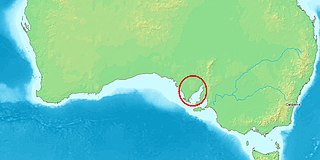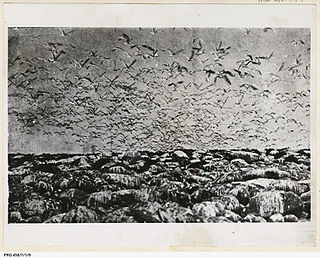
Protected areas of South Australia, consisting of protected areas located within South Australia and its immediate onshore waters and which are managed by South Australian Government agencies. As of 2018, South Australia contained 359 separate protected areas declared under the National Parks and Wildlife Act 1972, the Crown Land Management Act 2009 and the Wilderness Protection Act 1992. Together, they cover a total land area of 211,387.48 km2 (81,617.16 sq mi) or 21.5% of the state's area.

The Spencer Gulf is the westernmost and larger of two large inlets on the southern coast of Australia, in the state of South Australia, facing the Great Australian Bight. It spans from the Cape Catastrophe and Eyre Peninsula in the west to Cape Spencer and Yorke Peninsula in the east.

The Top End of Australia's Northern Territory is a geographical region encompassing the northernmost section of the Northern Territory, which aside from the Cape York Peninsula is the northernmost part of the Australian continent. It covers a rather vaguely defined area of about 245,000 square kilometres (95,000 sq mi) behind the northern coast from the Northern Territory capital of Darwin across to Arnhem Land with the Indian Ocean on the west, the Arafura Sea to the north, and the Gulf of Carpentaria to the east, and with the almost waterless semi-arid interior of Australia to the south, beyond the huge Kakadu National Park.

Acanthophis is a genus of elapid snakes. Commonly called death adders, they are native to Australia, New Guinea and nearby islands, and are among the most venomous snakes in the world. Despite their common name, they are not adders at all and belong to the Elapidae family. The name of the genus derives from the Ancient Greek akanthos/ἄκανθος ('spine') and ophis/ὄφις ('snake'), referring to the spine on the death adder's tail.

The Neptune Islands consist of two groups of islands located close to the entrance to Spencer Gulf in South Australia. They are well known as a venue for great white shark tourism.
Sibsey Island is an island in the Australian state of South Australia located in Spencer Gulf within the Sir Joseph Banks Group. It was discovered on 21 February 1802 by Matthew Flinders. Currently, the island is uninhabited.
English Island is an island off the coast of Eyre Peninsula in South Australia. It is a part of the Sir Joseph Banks Group and close to Sibsey Island. The island is most notable for its large colony of sea lions, and for a secession movement started by the eccentric and self-styled "Sir Ralph Styles of English Island" in 1954.

The mud adder, also known commonly as Devis's banded snake, is a species of venomous snake in the family Elapidae. The species is endemic to certain regions of eastern Australia, including South West Queensland, northern New South Wales, north-west Victoria, and South Australia. Its scientific and common names refer to Charles Walter De Vis.

The greater stick-nest rat, also known as the housebuilding rat and wopilkara, is a species of rodent in the family Muridae. They are about the size of a small rabbit and construct large nests of interwoven sticks. Once widespread across southern Australia, the population was reduced after European colonisation to a remnant outpost on South Australia's Franklin Islands. The species has since been reintroduced to a series of protected and monitored areas, with varying levels of success.

Echiopsis curta is a terrestrial, elapid species of snake, also commonly known from the Aboriginal name as the bardick. It is a short, highly venomous snake with variable color which is mainly nocturnal, reaching a maximum length of 57 cm. It is endemic to Australia, most commonly found in three distinct populations through southern Australia. They are considered venomous to humans, however there is very little information. Their population is decreasing due to habitat degradation and destruction but considered least concern on the IUCN Red List.

The Sir Joseph Banks Group is an archipelago in the Australian state of South Australia located in Spencer Gulf about 20 kilometres (12 mi) off the eastern coast of the Eyre Peninsula. It consists of 21 islands of which eighteen are in the Sir Joseph Banks Group Conservation Park while the surrounding waters are in the Sir Joseph Banks Group Marine Park. It is considered to be an important seabird breeding site.
Sir Joseph Banks Group Conservation Park is a protected area in the Australian state of South Australia located on the Sir Joseph Banks Group in Spencer Gulf about 25 kilometres (16 mi) east-northeast of Port Lincoln. The conservation park of which specific islands had been previously declared as Flora and Fauna Reserves under statutes in force prior to 1972, was proclaimed in 1972 under the National Parks and Wildlife Act 1972. It was declared ‘primarily for the conservation of Cape Barren geese, and to protect marine mammal habitat’. As of 1996, the conservation park did not include Spilsby island which is privately owned and ‘lighthouse reserves’ on other islands while the following islands have been added post-declaration - Reevesby Island which was added in 1974 and Dangerous Reef which was added in 1989. The conservation park was subsequently extended to include the waters within 2 nautical miles (4 km) of the shoreline of all islands in the group and Dangerous Reef via a declaration under the National Parks and Wildlife Act 1972 for the purpose of regulating and managing great white shark berleying activities. The conservation park is classified as an IUCN Category Ia protected area.
The Pages Conservation Park is a protected area in the Australian state of South Australia which is associated with the island group known as The Pages located in Backstairs Passage about 25 kilometres south-east of Cape Jervis and about 98 kilometres south south-west of the state capital of Adelaide.
Tumby Island is a low bedrock island located 500 m (1,600 ft) east of the southern tip of Tumby Bay in Spencer Gulf, South Australia. The island is a conservation park comprising 35 ha.
Neptune Islands Conservation Park is a protected area occupying most of the Neptune Islands in South Australia about 55 km (34 mi) south-south east of Port Lincoln. It was established in 1967 principally to protect a New Zealand fur seal breeding colony. The conservation park was subsequently expanded to include the adjoining waters in order to control and manage berleying activities used to attract great white sharks. As of 2002, the conservation park is the only place in Australia where shark cage diving to view great white sharks is legally permitted.
Hopkins Island is an island located in Spencer Gulf off the east coast of Jussieu Peninsula on Eyre Peninsula in South Australia approximately 32 km (20 mi) south-east of Port Lincoln. It was named by Matthew Flinders in memory of John Hopkins who was one of the eight crew lost from a cutter that capsized on 21 February 1802. Since 2004, the island has been part of the Memory Cove Wilderness Protection Area.

Dangerous Reef is an island and reef system located in the Spencer Gulf in the Australian state of South Australia about 32.5 kilometres (20.2 mi) east-southeast of the city, Port Lincoln. It is the southernmost member of the Sir Joseph Banks Group. It has been the site of a navigation aid since 1911. It is notable as the site of a breeding colony of Australian sea lions. The waters adjoining its shore are notable as a place to view great white sharks to the extent that it was both a popular gamefishing and shark cage diving venue during the twentieth century, and was used to film footage for the following motion pictures – Blue Water White Death and Jaws. The island has enjoyed protected area status since 1900 and it has been part of the Sir Joseph Banks Group Conservation Park since 1989.
Boucaut Island is a small, uninhabited island in the Sir Joseph Banks Group in South Australia's Spencer Gulf. It lies 1.2 km northeast of Spilsby Island. Seal Rock lies 250 metres southeast of Boucaut Island.

Stickney Island is an uninhabited island of the Sir Joseph Banks Group located in Spencer Gulf, South Australia.
Langton Island is a small, uninhabited island of the Sir Joseph Banks Group in Spencer Gulf, South Australia. The Island was named by Captain Matthew Flinders during his exploration of South Australia's coastline in 1802. Langton Island was named after Langton Hall in Lincolnshire. A "huge" breeding colony of Fairy terns was found on Langton Island by naturalists from the McCoy Society in 1937. Fishermen have caught whiting in nearby waters.











